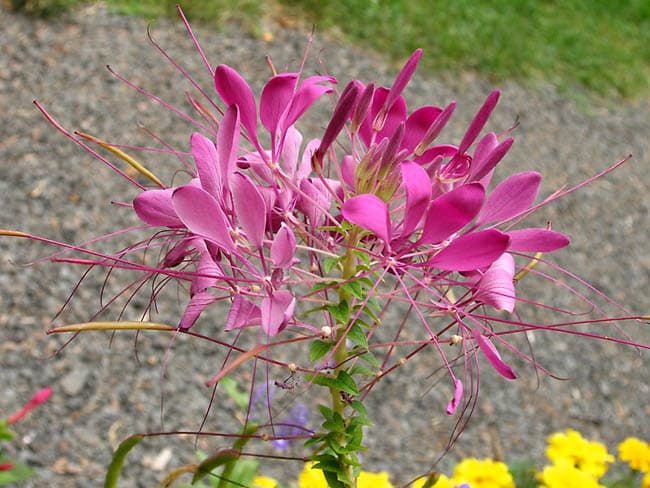An annual, semi-shrub plant about 100 cm high. The flowers are very peculiar, similar to a spider - four corolla petals are located on one side of the flower, and on the other - thin and long stamens and a column. The flowers are collected in a terminal multi-flowered brush, bloom from bottom to top and the brush is gradually stretched out. From faded flowers, elongated capsules on long stalks are formed, directed in different directions.
The plant is light and heat-loving, drought-resistant, does not tolerate stagnant water.
Propagated by seeds, which are sown on seedlings in the spring (stratification is needed at +4 °C) or in open ground before winter. Seedlings appear in two weeks.
Care consists in regular weeding, loosening, top dressing, and in dry summers and watering.

* Spiny spiderflower (Cleoma) is a very spectacular plant, immediately catches the eye, even if it is planted in the background of a large flower garden. However, it looks best in a small group or alone among shorter flowers or green lawns. Cut for more than 10 days, recommended for original flower arrangements.
Location: the plant is light and heat-loving, rather drought-resistant.
Soil: prefers neutral soils and does not tolerate waterlogging.
Reproduction: by seeds, which are sown in March in a greenhouse or before winter to a depth of 1-1.5 cm. Seedlings do not appear together in two weeks. Seedlings dive into peat-humus pots and at the end of May are planted in a permanent place according to the scheme 30 x 50 cm.
Usage: cleoma - this spectacular plant immediately catches the eye, even if it is planted in the background of a large flower garden. And even better, the plant looks in a small group or alone among shorter flowers. Cut cleoma inflorescences stay in water for more than 10 days, so they can be used for original flower arrangements.
Eng.: Spiny spiderflower. Bot. syn.: Cleome sandwicensis Gray, Neocleome spinosa (Jacq.) Small.












